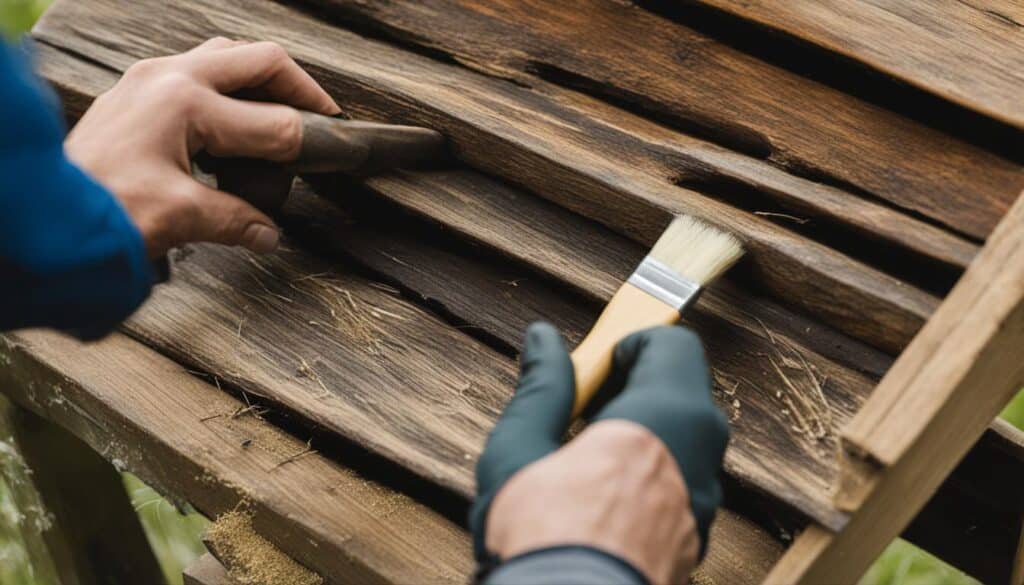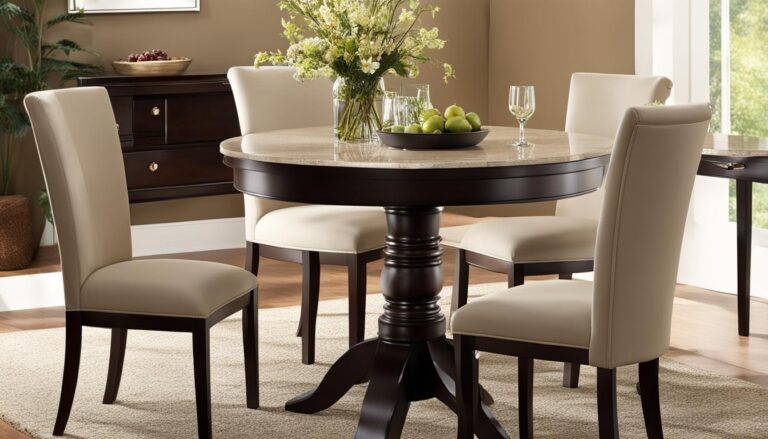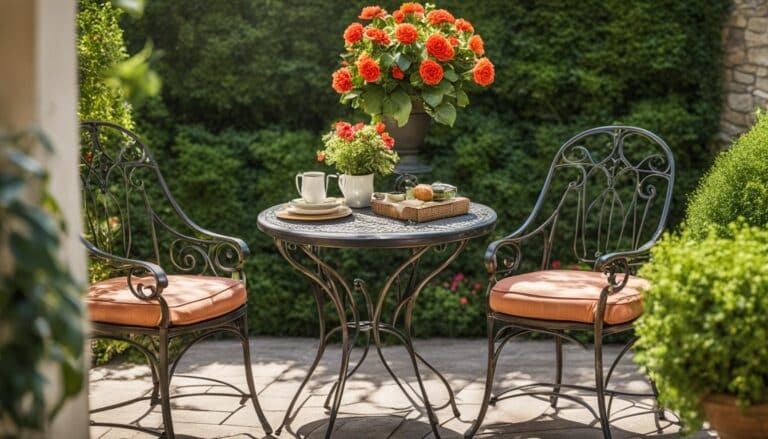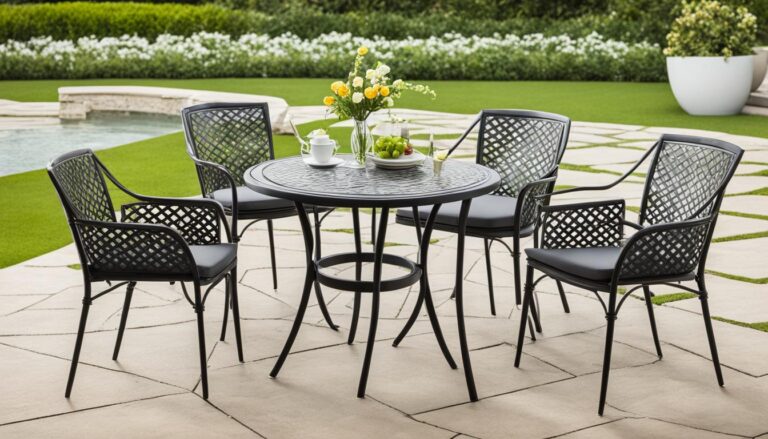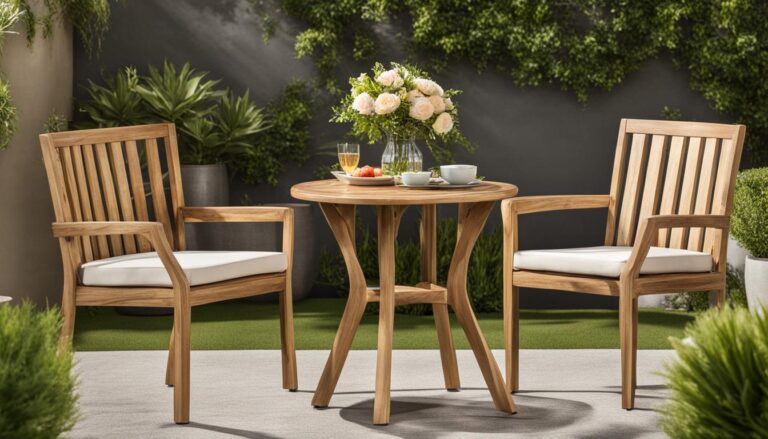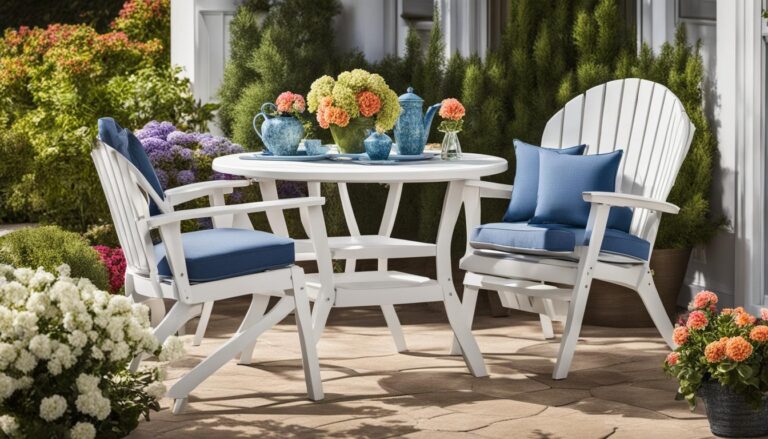Restoring outdoor wood furniture doesn’t have to be difficult. Follow this step-by-step guide to bring new life to your weathered pieces. From cleaning and sanding to priming and staining, these simple steps will help you restore your outdoor wood furniture and make it look brand new again.
Key Takeaways:
- Restoring outdoor wood furniture is an achievable DIY project.
- Proper cleaning and sanding are essential for successful restoration.
- Priming and staining help protect the wood and enhance its appearance.
- Regular maintenance is key to prolonging the lifespan of your restored furniture.
- Protecting your outdoor wood furniture from the elements is vital for its longevity.
Supplies Needed for Restoring Outdoor Wood Furniture
If you’re ready to restore your outdoor wood furniture, it’s important to gather all the necessary supplies before you begin. Having everything on hand will make the process easier and more efficient. Here are the essential supplies you’ll need:
- Exterior wood stain and sealer: Choose a high-quality stain and sealer specifically designed for outdoor use. This will protect your furniture from moisture, UV rays, and other elements.
- Stain brush or chip brush: A brush with natural bristles is ideal for applying the stain evenly and smoothly.
- Paint stir stick: Use a stir stick to mix the stain thoroughly before applying it to the furniture.
- Rubber gloves or disposable latex gloves: Wearing gloves will protect your hands from the stain and make cleanup easier.
- Sandpaper: Choose sandpaper with varying grits, such as coarse, medium, and fine, to help you achieve a smooth finish.
- Clean cloth or rag: You’ll use a cloth or rag to wipe off excess stain and clean up any spills.
- Optional electric sander: An electric sander can save you time and effort, especially if you have larger pieces of furniture to restore.
Having these supplies ready will ensure that you have everything you need to restore your outdoor wood furniture effectively and efficiently. Now that you’re prepared, let’s move on to the first step: cleaning your furniture.
Cleaning Your Outdoor Furniture
Before you can begin the restoration process, it’s crucial to thoroughly clean your outdoor wood furniture. This step will remove dirt, grime, and any leftover old stain or sealant. Here’s how to do it:
- Start by removing any loose debris from the furniture using a brush or cloth.
- Mix a solution of warm water and mild soap in a bucket.
- Dip a cloth or sponge into the soapy water and scrub the surfaces of the furniture, paying special attention to any stained or dirty areas.
- Rinse the furniture thoroughly with clean water to remove all soap residue.
- Allow the furniture to dry completely before moving on to the next step.
By cleaning your outdoor wood furniture before restoring it, you’ll ensure that the new stain adheres properly and that the final result is a beautifully refreshed piece of furniture.
Step 1: Cleaning Your Outdoor Furniture
Before you begin the restoration process, it’s crucial to clean your outdoor wood furniture thoroughly. This step is essential to remove dirt, dust, and other debris that may have accumulated over time. Start by using a cloth or brush to wipe down the surface and remove loose particles. For more stubborn stains or mildew, consider using a jet sprayer attachment or a soft wash pressure washer to ensure a deeper clean.
When using a pressure washer, be cautious not to use excessive force, as it can damage the wood. Allow your furniture to dry completely before moving on to the next step, as moisture can affect the quality of the stain and primer.
Tools and Supplies:
- Cloth or brush
- Jet sprayer attachment or soft wash pressure washer
Tips for Cleaning:
- Wipe down the furniture regularly to prevent dirt buildup.
- Consider using a mild soap or wood cleaner for tougher stains.
- Avoid using harsh chemicals or abrasive cleaners, as they can damage the wood.
By thoroughly cleaning your outdoor wood furniture, you’re preparing it for the restoration process and ensuring that the subsequent steps will be more effective in rejuvenating its appearance.
Step 2: Sanding the Wood
Once you have thoroughly cleaned your outdoor wood furniture, the next step in the restoration process is sanding. Sanding is crucial for removing any rough spots, flaking paint, or old stain from the surface of the wood. It creates a smooth and even surface for the new stain to adhere to, ensuring a flawless finish.
To sand the wood, you can use sandpaper or an electric sander. If you have small or intricate areas, sandpaper may be the better option as it allows for more precise sanding. However, if you have large surfaces to sand, an electric sander can save you time and effort.
Start by sanding the entire surface of the furniture, paying special attention to areas that are cracking or showing signs of wear. Sand in the direction of the wood grain to avoid damaging the fibers. Once you’re finished sanding, use a cloth or brush to remove any sanding dust from the furniture before proceeding to the next step.

Key Points:
- Sanding is essential for creating a smooth surface for the new stain to adhere to.
- Choose between sandpaper or an electric sander based on the size and intricacy of the furniture.
- Pay special attention to areas that are cracking or showing signs of wear during sanding.
- Remove any sanding dust from the furniture before moving on to the next step.
Step 3: Priming and Staining
Now that you have cleaned and sanded your outdoor wood furniture, it’s time to move on to the next crucial step: priming and staining. These steps will help protect the wood from weather damage and enhance its appearance. Here’s how you can effectively prime and stain your furniture:
1. Apply a primer:
Start by applying a high-quality primer specifically designed for outdoor use. This will create a smooth, sealed surface that will help the stain adhere better and protect the wood from moisture. Use a brush or roller to evenly apply the primer, following the manufacturer’s instructions. Allow the primer to dry completely before moving on to the next step.
2. Choose the right stain:
Select an exterior wood stain that is suitable for outdoor furniture refurbishment. Consider factors such as the desired color, level of protection, and the natural characteristics of the wood. It’s recommended to choose a stain that offers UV protection to prevent fading caused by sun exposure. Stir the stain thoroughly before applying it to ensure an even color.
3. Apply the stain:
Using a brush or a clean cloth, apply the wood stain in long, even strokes, following the direction of the wood grain. Work in small sections to ensure that the stain is applied evenly. If you prefer a darker color, you can apply multiple coats, allowing each coat to dry completely before adding the next. Remember to wipe off any excess stain to avoid blotches or uneven coloring.
By following these steps, you can effectively prime and stain your outdoor wood furniture, restoring its beauty and protecting it from the elements. Now, let’s move on to the next section to learn how to protect your restored furniture for long-lasting enjoyment.

Protecting Your Restored Wood Furniture
Now that you have successfully restored your outdoor wood furniture, it’s crucial to take the necessary steps to protect it and ensure its longevity. By implementing proper protection measures, you can enjoy your beautifully restored furniture for many years to come.
1. Use Outdoor Furniture Covers
When your outdoor wood furniture is not in use, it is essential to protect it from the elements. Invest in heavy-duty outdoor furniture covers that are specifically designed to shield your furniture from rain, snow, sunlight, and other weather conditions. These covers will prevent moisture damage, fading, and other forms of wear and tear, keeping your furniture looking pristine.
2. Apply a Transparent Sealing Topcoat
Applying a transparent sealing topcoat once a year provides an extra layer of protection for your restored wood furniture. This topcoat acts as a barrier against moisture, UV rays, and other environmental factors that can damage the wood. Make sure to choose a topcoat that is suitable for outdoor use and follow the application instructions provided by the manufacturer.
3. Use a Wood Conditioner and Protectant with UV Protection
To maintain the appearance of your outdoor wood furniture and protect it from the sun’s harmful UV rays, consider using a wood conditioner and protectant that includes UV protection. These products nourish the wood, enhance its natural beauty, and create a protective barrier against UV damage. Apply the conditioner and protectant as directed on the product packaging for optimal results.
4. Regularly Clean and Inspect Your Furniture
To keep your restored wood furniture in top shape, it’s essential to clean it regularly and perform routine inspections. Remove any dirt, dust, or debris using a mild detergent and water. Avoid harsh cleaning agents that can damage the wood’s finish. Additionally, inspect your furniture for any signs of wear, such as splintering or cracking, and address these issues promptly to prevent further damage.
By following these protection measures and practicing regular maintenance, you can extend the lifespan of your outdoor wood furniture and enjoy its beauty year after year.
Maintenance Tips for Outdoor Wood Furniture
Now that you have successfully restored your outdoor wood furniture, it’s important to take proper care of it to ensure its longevity. By following these maintenance tips, you can keep your furniture looking its best for years to come.
Regular Cleaning
Regular cleaning is essential to remove dirt, dust, and debris from your outdoor wood furniture. Use a mild soap or wood cleaner and a soft brush or cloth to gently scrub the surface. Rinse thoroughly with water and allow the furniture to dry completely before using or covering it.
Inspect for Wear and Damage
Periodically inspect your outdoor wood furniture for any signs of wear or damage. Check for cracks, splinters, or loose joints, and address these issues promptly. If necessary, sand and refinish the affected areas to prevent further damage and keep your furniture in good condition.
Protect from Sun and Extreme Weather
Excessive sunlight and extreme temperature changes can cause your outdoor wood furniture to fade, warp, or crack. To protect it, consider placing your furniture in shade or using an umbrella to provide some coverage. Additionally, during harsh weather conditions, such as heavy rain or snow, it’s best to cover your furniture with waterproof and breathable outdoor furniture covers.
Use Coasters and Mats
To prevent damage from hot dishes or wet glasses, use coasters or mats on your outdoor wood furniture. This will protect the surface from heat and moisture, minimizing the risk of stains, water damage, or unsightly marks.
By implementing these maintenance tips, you can preserve the beauty and durability of your restored outdoor wood furniture. With proper care and attention, your furniture will continue to be the centerpiece of your outdoor space, providing comfort and enjoyment for years to come.
Conclusion
Restoring outdoor wood furniture is a rewarding DIY project that can bring new life to your outdoor space. By following this step-by-step guide and implementing proper maintenance, you can protect your furniture and enjoy it for years to come.
Remember to gather all the necessary supplies before starting the restoration process. Exterior wood stain and sealer, sandpaper, and a clean cloth or rag are essential for cleaning and refinishing your furniture.
Once your furniture is restored, it’s important to protect it from the elements. Consider using heavy-duty outdoor furniture covers when it’s not in use, and apply a transparent sealing topcoat annually for added protection. Regular cleaning and maintenance will also help extend the lifespan of your outdoor wood furniture.
By following these wood furniture restoration tips and taking proper care of your outdoor pieces, you can create a welcoming outdoor oasis that will withstand the test of time.
FAQ
Can I use any type of wood stain for outdoor furniture?
It is recommended to use an exterior wood stain and sealer specifically designed for outdoor use. These stains provide protection against the elements and help prevent fading and weathering.
Do I need to sand the wood before applying the primer?
Yes, sanding the wood is an important step in the restoration process. It helps remove any rough spots, flaking paint, or old stain, creating a smooth surface for the new stain to adhere to.
How many coats of stain should I apply?
The number of coats of stain you apply will depend on the desired color and coverage. Apply one coat of stain and allow it to dry completely before deciding if additional coats are needed. Repeat the process until you’ve achieved the desired results.
How often should I apply a topcoat sealer?
It is recommended to apply a transparent sealing topcoat once a year to provide additional protection to your outdoor wood furniture. This will help prevent moisture damage and maintain the appearance of the wood.
How do I clean my restored outdoor wood furniture?
Regular cleaning is important to keep your furniture looking its best. Use a mild detergent or wood cleaner and a soft brush or cloth to remove dirt and debris. Rinse thoroughly with water and allow it to dry completely.
What can I do to protect my outdoor wood furniture from the elements?
To protect your furniture from the elements, you can use heavy-duty outdoor furniture covers when it is not in use. This will help shield it from rain, snow, and UV rays. Additionally, applying a wood conditioner and protectant with UV protection can help maintain its appearance.
How do I address signs of wear or damage on my outdoor wood furniture?
If you notice any signs of wear or damage, address them promptly to prevent further deterioration. Repair cracks or splits with wood filler and sand them smooth. Touch up any areas with new stain or paint, following the same steps as the restoration process.
Can I leave my restored outdoor wood furniture outside all year?
While outdoor wood furniture is designed to withstand the elements, it is recommended to take some precautions. Avoid exposing the furniture to excessive sunlight or extreme temperature changes. Using coasters or mats to protect the surface from heat and moisture can also help prolong its lifespan.

